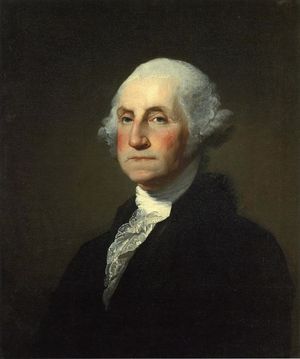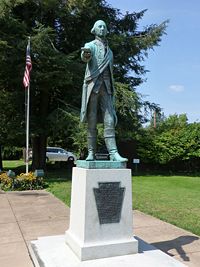George Washington
 George Washington (1732-1799) - Born 22 Feb 1732 in Westmoreland County, Virginia. A founding Father of the United States of America and known as the "Father of His Country". Commander in Chief of the Continental Army during the American Revolution. First President of the United States serving from 30 Apr 1789 to 4 Mar 1797. Died 14 Dec 1799 at Mount Vernon, Virginia. Buried 18 Dec 1799 at his Mount Vernon home. Early YearsGeorge Washington was born 22 Feb 1732 in Westmoreland County, Virginia to Augustine and Mary Ball Washington. He was mostly raised at Ferry Farm in Stafford County near Fredericksburg, Virginia. George inherited Ferry Farm from his father and Mount Vernon from Lawrence, his half brother. George was appointed official surveyor for Culpeper County in 1749 at age 17. This was a well-paying position with access to purchase land in the Shenandoah Valley.
French & Indian War (1754-1763) George Washington was appointed a Virginia militia district adjutant by Virginia Lieutenant Governor Robert Dinwiddie in February 1753, with the rank of major. In this capacity, Dinwiddie sent Washington to the French Fort le Boeuf with instructions that the French were to leave the Ohio Valley. The French declined to do so and Washington returned. In 1754 Washington led an expedition that ambushed a party of 35 French Canadiens commanded by Joseph Coulon de Villiers de Jumonville. Jumonville was killed under dubious circumstances and the French retaliated by sending a force from Fort Duquesne to intercept Washington. The French caught up with Washington's command at FortNecessity defeated them and capturing Washington and his command. Washington was compelled to sign a surrender that included a statement (in French) that Jumonville had been assassinated. Washington and his command were released to return to Virginia. At this point, the French & Indian War had not yet been formally declared and this incident is cited as one of the events that caused the declaration in 1756. George Washington was a senior aide to British General Edward Braddock's during his disastrous expedition to capture Fort Duquesne in 1758. Washington somehow survived an ambush that killed many of the officers and he organized the retreat. He bore the mortally wounded Braddock from the battlefield. Braddock left Washington his ceremonial sash and Washington reportedly never went anywhere without it. In a third attempt to capture Fort Duquesne now Colonel George Washington commanded the Virginia Militia forces in General John Forbes successful expedition against the French fort in 1758. Washington began the war as an inexperienced 21-year-old officer and at the end emerged an experienced professional senior officer who had learned many difficult lessons. He resigned his Virginia Regiment commission in December 1758 and returned home.
Family LifeOn 6 Jan 1759, George Washington married a wealthy widow Martha Dandridge Custis. George and Martha had no children together but they raised Martha's two children from her first marriage. George and Martha moved to Mount Vernon and George became a planter and local political figure. He expanded his land holdings through land grants from his service in the French & Indian War and by purchases. In August 1774 Washington attended First Virginia Convention, where he became a delegate to the First Continental Congress. Revolutionary War (1775-1783)The revolution began in earnest with the Battles of Lexington and Concord in April 1775. Washington appeared before the Second Continental Congress in military uniform declaring himself ready to fight and when the Continental Army was created on 14 Jun 1775 he was appointed Commander in Chief. The early years of the war were marked by great trials and tribulations for the Continental Army. There were deficiencies everywhere, men, training, supplies and competent officers. Washington kept his army in the field continuously and after finding able commanders and with experienced troops things began to turn around. The tide began to turn with victories at Trenton and Princeton in 1776-1777 and the British were forced to retreat back to New York. A stunning American victory at Saratoga on 17 Oct 1777 brought the French into the war on the American side and marked the turning point of the war. General Washington emerged from his winter quarters at Valley Forge in 1778 with a far better-trained army and through victories like Monmouth began to push the British back into New York. In the south important victories at King's Mountain in October 1780 and at Cowpens in February 1781 forced the British army up into Yorktown, Virginia where they awaited evacuation by ship to safety in New York. A French naval victory over the British evacuation fleet eliminated the possibility of evacuation for the British army and left them trapped at Yorktown. Washington's army and the French forces under Comte de Rochambeau joined up and quickly moved down into Virginia and surrounded the British at Yorktown under Lieutenant General Charles Cornwallis. The siege of Yorktown began on 28 Sep 1781 and ended 19 Oct 1781 with the British surrender. The British defeat and surrender at Yorktown on 19 Oct 1781 marked the end of major hostilities but it was not until the Treaty of Paris (1783) was ratified that the British in New York began to leave. With the British departure, Washington disbanded the army delivering his famous farewell address on 2 Nov 1783. On 4 Dec 1783 Washington said farewell to his officers in New York City and on 23 Dec 1783 he resigned his commission as commander-in-chief. His resignation shocked the world and helped to establish the American democratic concept of peaceful transition of power.
United States Constitution (1787)Washington attended the Constitutional Convention in Philadelphia in the summer of 1787. He was unanimously elected president of the Convention and by his countenance and leadership, the convention produced a document that was ratified by all thirteen states. In the very first presidential election, the Electoral College unanimously elected George Washington president in 1789.
President (1789-1797)George Washington served two terms as president and declined a third. He was an excellent administrator and since everything, he did set a precedent he took great care not to set bad or dangerous precedents. He established the cabinet form of government and the role of the President as Commander in Chief. He declined to run for a third term and returned to life at Mount Vernon and by doing so he reinforced the peaceful transition of power concept and set the two-term precedent that exists today. George Washington died at his home in Mount Vernon on 14 Dec 1799. He was buried 18 Dec 1799 at his Mount Vernon home. People throughout the world mourned his passing. Father: Augustine Washington (1694–1743) Mother: Mary Ball Washington (1708–1789) Marriage:
Children:
Personal Description:
See Also: Sources: |